Table of Contents
Participatory Processes
Why participatory processes
- building trust with citizens
- involvement and building active citizenship and ownership
- co-creation brings responsibility and is also involving citizens into decision making
- it brings connections and more solidarity into local communities
When do we do participatory activities?
- When we want changes in local community
- To open space for participatory budgets
- To address the important documents
- To make the strategies of the community
- To open the space to do decision making process collectively
- To connect different stakeholders (researchers, field workers, decision makers, “general public”)
Lessons learned and what to be mindful about
- Political support to this processes is crucial in the start, so have a speech of Major or somebody responsible for the field about which we discuss. This brings trust and clarity to the event.
- Participatory processes take time and people need to get used to them, so being patient is the key.
- Keep promises and do what you have promised to people.
- Establish a safe space and put people in small groups, people tend to talk more in the small groups.
- Inclusive wording – “establishing community”, “your opinion matters”, “together we can achieve more” is crucial to be heard.
Methodologies
The methodologies are used with the focus on proactive participation of participants in the live settings. There are several approaches, that can help the groups to grow together and explore the topics, that are important to them. There are different methodologies addressing that.
Pro action Café
As a conversational process, the Pro action Café is a collective, innovative methodology for hosting conversations about calls, questions and projects that matter to the people that attend. These conversations link and build on each other as people move between café tables, cross-pollinate ideas, and offer each other new insights into the questions or issues that are most important in their life, work, organization or community. As a process, the Pro action Café can evoke and make visible the collective intelligence of any group, thus increasing people’s capacity for effective action in pursuit of good work. It can be used with a network of people and/or as a methodology for specific group / organization / community to engage in creative and inspirational conversation leading to wiser and more collectively informed actions1.
What is Pro Action Café Good For?
As a conversational process, the Pro Action Café is a collective, innovative yet simple methodology for hosting conversations about calls, questions and projects that matter to the people that attend. These conversations link and build on each other as people move between café tables, cross-pollinate ideas, and offer each other new insights into the questions or issues that are most important in their life, work, organisation or community.
As a process, the Pro Action Café can evoke and make visible the collective intelligence of any group, thus increasing people’s capacity for effective action in pursuit of good work. Pro Action Café can be used with a network of people and/or as a methodology for a specific group, organisation or community to engage in creative and inspirational conversation leading to wiser and more collectively informed actions.
Pro Action Café is also a growing global community of people, groups, organizations and networks that practice this conversational format.
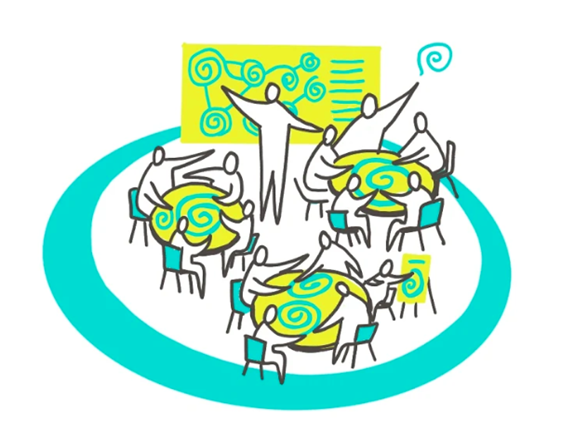
Collective harvesting
Collective Story Harvesting is a storytelling process to unveil multiple aspects, facets, and insights hidden deeply in the experiences of individuals, communities, teams or organisations. The process is about to sharpen the listening and concentrating on certain pre-agreed details and topics in the story when it is told (Fenton, 2015).
Storytelling is mankind’s oldest knowledge management tool – and still one of the most effective. Our stories contain both the experience and learning that can grow our capacity to function in our increasingly complex contexts.
Collective harvesting allows us to track many threads or aspects of a single story simultaneously. We can practice targeted listening, group learning and collective meaning making, as well as offering a tremendous gift to the story holder. Group harvesting is an ideal way to surface the many insights, innovations an a-ha’s that dwell beneath the surface of our stories, using the full wealth of the diverse perspectives present in any group in order to enrich the experience and understanding of the group as a whole.
Preparation Phase
Allow enough time – You need to allow at least 90 minutes for the whole process. If you’re working with people who haven’t done this type of process before, keep the storytelling to around 30 minutes so people don’t get overloaded. If you want to maximise the learning around a story, you may want to work on the interplay between story, harvest and learning for half a day, a day or even longer.
Select the story with care
- You will need a story that is relevant to the purpose and the context or system you wish to serve with this exercise. Ideally it should have enough complexity, scale and duration to make it interesting.
- The best people to tell the story are those who are directly connected to it. It can be more interesting to hear from more than one person involved in the story. More voices add depth and richness, as well as a variety of points of view.
- The story does not have to be an often-told one, or polished in any form. In fact, this process can be used to help polish a story and enable the storytellers to focus and refine it for different audiences.
- Take care with your invitation
- Be intentional about how you invite the story holders to come and tell their story. Stories respond to invitation, and when a heartfelt invitation is present, often a story will come out in a whole new way and offer new learning to those telling it. A group harvest is a gift to those telling and those harvesting, and should be offered as such.
- Select the threads
- Decide on the threads you want to harvest. Ideally, this should be agreed with the story holders and the listeners, depending on where they want to focus their learning. Take as much time as you need to discuss exactly what you want to get out of this process and what will happen to the harvest afterwards. You’ll need at least one person harvesting each thread you’ve chosen, and more than one person can harvest the same thread simultaneously.
- Possible threads to choose from:
- Narrative thread* – The thread of the story – people, events, stages. You might also capture facts, emotions and values that are part of the story.
- Process* – What interventions, processes, applications, discoveries happened?
- Pivotal points* – When did breakthroughs occur? What did we learn?
- Application – What can we learn from this story about application in our own or other systems?
- Taking change to scale – What can we learn from this story about taking change to scale?
- Questions – What questions arise from this story that we could ask of any system?
- When things just came together – What where the times when the right people showed up and things just flowed naturally? (Synchronicity & magic)
- Specific theme – Harvest the story using a specific theme (like participatory leadership) and see what it tells you.
- Specific participatory leadership patterns – e.g. the eight breaths of process design: where did each breath occur during the story? The 5th organisational paradigm: Where did new forms of governance and working occur? Core team/calling team: What did we learn about holding the centre of this work?
- Principles – What principles of working can be gleaned from this story? What principles of complex living systems were reflected in this work?
- Challenges encountered and how they were overcome
- The story field* – How did the field of the system’s story change? Can you name the story or metaphor the system started with and what it moved to?
Threads marked with * might be foundational to any harvesting process2.
Identify other possible harvesting modes
If you have other talents in your group, around graphic facilitation/visuals, poetry, music, mind mapping, art, etc., you might also want to invite harvest in this form. Each of these will add a greater richness, diversity and enjoyment to the harvest.
Suggested process
Framing and introduction: Welcome people to the session. Make the invitation publically to the storytellers. Explain the harvesting threads and ask for volunteers.
Storytelling: Ask the storytellers to tell the story and the group to harvest. Be clear about the time allocated for the storytelling. (It can be helpful to use a chime to let the storytellers know when they have 5 minutes left)
Collective harvest:
Give the storytellers materials to do their ‘harvest of the harvest’. Ask each of the harvesters to report on what they found. Take at least as long for this as for the storytelling. Each of the harvests will have more depth than can be told during a first round. It might be helpful to have more than one round of harvest, or for the rest of the group to question each harvester to draw out additional insights.
Response from the tellers: What were the gifts to you from this group harvest? What are you taking away from this session?
Closing the session:
Thank the storytellers and the harvesters. Any final remarks about what will happen to the harvest now that it has been heard. Is there enough here to return to it again and see what else surfaces? Do you want to come back as a group and hear the next version of the story?
Materials and set-up
Room set-up:
Ideally create a large circle with the storytellers as part of the circle. You may need some small tables for those harvesting onto flipcharts (or they may be OK sitting on the floor).
Supplies: coloured pens and other art supplies.
Equipment:
– Recording equipment if you want to video the process and its results.
– Camera to photograph any graphic harvests there might be.
What else is collective story harvesting good for?
For the story holders
Collective harvesting is an ideal input both for taking stock of the learning so far in a project and for polishing a story so that it can be told to another audience. Having external ears listen to your story can help to surface things you haven’t seen or haven’t taken notice of during the time you were living in the experience. Often an experience is so complex and moves forward with such speed that it is almost impossible to see how it all fits together from the inside.
We suggest using a collective harvest to take stock at regular intervals during a project’s life. Being well witnessed can be both a blessing and a relief to people who’ve done the hard yards holding the space for something to happen. Good witnessing enables insights about the key pivotal points in a story to surface, as well as helping other emotions to be heard and released. Deep listening can help a story to identify its protagonists’ strengths and gifts, as well as the supports and barriers they faced in contributing those gifts. It can also support a story to rise above the personal to reveal insights about the local context it happened in and even the wider systemic context.
Just as external eyes can help us see something we know well in a new light, external listeners can help story participants to see their own experiences in a new light, often revealing what has not been seen from inside the story. Even such a simple thing as naming what has not been named before adds immensely to the learning.
Specific feedback can also help a team to know what to focus on in polishing their story. Often there are so many details held by the team, that a listener can be overwhelmed. Harvesting can help to bring what’s important into sharp relief, supporting a story to become more focused and more potent.
For the Listeners and Harvesters
If storytelling is a skill that is both inherent to humans and one that can be polished with practice, then so is listening. Listening is the companion skill to storytelling; indeed, the story arises in the space between the teller and the listener. In essence, a story needs a listener to become what it can be. We don’t often get the opportunity to listen well, especially with a specific purpose, and to provide a necessary feedback loop to those within a committed project. Group story harvesting can provide such a practice and feedback loop, strengthening the community around a project shared in this way (Arthur, 2020).
Harvesting is also a skill that needs practice, and it is important to experience the wide variety of ways a story or an experience can be harvested, each bringing its own richness, much as another facet brings sparkle to a gemstone. Purposeful harvesting is both a good experience and an excellent way to practice. Story listeners and harvesters may want to debrief afterwards on their experience, surfacing their challenges and learning as a way for the group to become more skilful in the future.
For the wider community and networks
Harvests of projects that have gone to scale, as well as those that have faced many challenges are a valuable contribution to the wider community and beyond, helping us to increase the learning within our networks. Sharing practice stories is one of the quickest ways for principles and practices in any field to be understood and integrated (Arthur, 2020).
The strengths of Collective Story Harvesting
- It can deal with complex realities and bring simplicity as well as surface understanding and learning from complexity.
- It is a harvesting of current reality – how we got to where we are now?
- It creates a rich learning field.
- It creates a strong connection and shared understanding between those involved in the process.
- It is a gift to the storytellers and others, with lots of resonant learning happening.
- It is a simple, but powerful tool that can be used regularly to take stock, capture learning and refocus the field.
Applying collective story harvesting
There are many ways to apply collective story harvesting:
Systemic story harvest for applied learning: a group focuses on one systemic story to harvest the learnings and apply them to its own work. As in the process described above, a systemic story is told, the group harvests threads and discusses the learnings. This works equally well for a practice group or a working team hearing a story from another organisation or system and then applying the learnings to its own practice.
Full system team building/strategy session: Harvesting an organisation or group’s own story for learning, teambuilding and strategic enhancement. Working with the story in this way brings the group into a collective field of meaning. Vision or mission statements can be enhanced and integrated, strategic plans can be invigorated.
Many stories/collective learning: Harvesting a variety of stories simultaneously in small groups, then converging the learning across the full group. A variety of stories are selected that offer different aspects to the group. Participants attend and harvest the story that most interests them. Collective meta-learning is harvested by the full group.
Creating a new field of work or practice: Telling the story of the wider context up to now in order to set the scene for the new work or practice field to arise in find its potent focus. This process might also be used for systemic evaluation (Arthur, 2020).
World Café
Drawing on seven integrated design principles, the World Café methodology is a simple, effective, and flexible format for hosting large group dialogue. Each element of the method has a specific purpose and corresponds to one or more of the design principles. World Café can be modified to meet a wide variety of needs. Specifics of context, numbers, purpose, location, and other circumstances are factored into each event’s unique invitation, design, and question choice (Brown, Isaacs, 2020).


Operating Principles of World Café
- Create hospitable space
- Explore questions that matter
- Encourage each person’s contribution
- Connect diverse people and ideas
- Listen together for patterns, insights and deeper questions
- Make collective knowledge visible


Assumptions of World Cafe:
- The knowledge and wisdom we
- need is present and accessible.
- Collective insight evolves from
- honouring unique contributions;
- connecting ideas; listening into
- the middle; noticing deeper
- themes and questions.
- The intelligence emerges as the
- system connects to itself in
- diverse and creative ways.
General Flow of a World Café:
- Seat 4-5 people at café-style tables or in conversation clusters.
- Set up progressive rounds of conversation, usually of 20-30 minutes each—have some good questions!
- Ask one person to stay at the table as a “host” and invite the other table members to move to other tables as ambassadors of ideas and insights
- Ask the table host to share key insights, questions, and ideas briefly with new table members, and then let folks move through the rounds of questions.
- After you’ve moved through the rounds, allow some time for a whole-group harvest of the conversations.
What is World Café Good For?
World Café is a great way of fostering interaction and dialogue with both large and small groups. It is particularly effective in surfacing the collective wisdom of large groups of diverse people. The café format is very flexible and adapts to many different purposes—information sharing, relationship building, deep reflection exploration and action planning.
When planning a café, make sure to leave ample time for both moving through the rounds of questions (likely to take longer than you think!) and some type of whole-group harvest (theworldcafe.com, 2020).
Materials Needed:
- Small tables (36-42”), preferably round
- Chairs for participants and presenters
- Tablecloths
- Flip chart paper or paper placemats for covering the tables
- Markers
- Flip chart or large paper for harvesting collective knowledge or insights
- Posters/table tents showing the Café Etiquette
- Materials for harvesting
Image elements recognition
With image elements recognition we give people the space with several different images connected to the topic, we are discussing. With this elements people get associations, ideas and new aspirations on how to resolve the specific challenges. It is a very effective method for participant, that are very visual type of learners.
How do we do that?
We ask participants to bring the images of their territories or something that is connected with sustainability and sustainable development. Through the series of questions and associations they start to debate how to achieve or develop certain standards, how to proceed with certain steps In the process. We can link the images to any of the processes or topics we are working with.

Round 1:
What do you see on the picture?
How are participatory processes beneficial for the development of the tourism in the area?
How can different stakeholders participate in the process of strategy and why is it important to lead participatory and transparent processes with inclusion of the different groups?
Round 2:
Questions concerning the development of different aspects, how to include specific stakeholders into the processes and when.
Design thinking
Design thinking refers to the cognitive, strategic and practical processes by which design concepts (proposals for new products, buildings, machines, etc.) are developed. Many of the key concepts and aspects of design thinking have been identified through studies, across different design domains, of design cognition and design activity in both laboratory and natural contexts. Design thinking is also associated with prescriptions for the innovation of products and services within business and social contexts (Visser, 2006). The methodologies and Canvases of design thinking help participants to think more strategically and rethink certain aspects of their functioning.
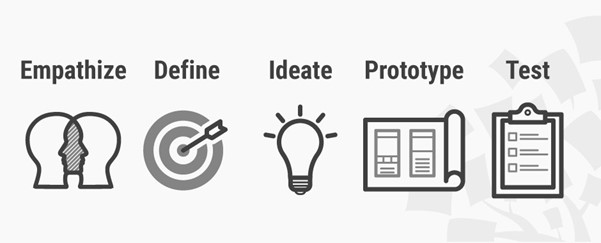
Why Is Design Thinking so Important in Today’s World?
Over recent decades, it has become crucial to develop and refine skills which allow us to understand and act on rapid changes in our environment and behavior. The world has become increasingly interconnected and complex, and design thinking offers a means to grapple with all this change in a more human-centric manner.
Design teams use design thinking to tackle ill-defined or unknown problems (otherwise known as wicked problems) because the process reframes these problems in human-centric ways, and allows designers to focus on what’s most important for users. Design thinking offers us a means to think outside the box and also dig that bit deeper into problem solving. It helps designers carry out the right kind of research, create prototypes and test out products and services to uncover new ways to meet users’ needs.
The design thinking process has become increasingly popular over the last few decades because it was key to the success of many high-profile, global organizations—companies such as Google, Apple and Airbnb have wielded it to notable effect, for example. This outside the box thinking is now taught at leading universities across the world and is encouraged at every level of business.
Design thinking improves the world around us every day because of its ability to generate ground-breaking solutions in a disruptive and innovative way. Design thinking is more than just a process, it opens up an entirely new way to think, and offers a collection of hands-on methods to help you apply this new mindset.

The Five Stages of Design Thinking
The Hasso Plattner Institute of Design at Stanford, commonly known as the d.school, describes design thinking as a five-stage process. It’s important to note these stages are not always sequential and designers can often run the stages in parallel, out of order and repeat them in an iterative fashion.
The various stages of design thinking should be understood as different modes which contribute to the entire design project, rather than sequential steps. The ultimate goal throughout is to derive as deep an understanding of the product and its users as possible.
Stage 1: Empathize—Research Your Users’ Needs
The first stage of the design thinking process allows you to gain an empathetic understanding of the problem you’re trying to solve, typically through user research. Empathy is crucial to a human-centred design process like design thinking because it allows you to set aside your own assumptions about the world and gain real insight into users and their needs.
Stage 2: Define—State Your Users’ Needs and Problems
In the Define stage, you accumulate the information you created and gathered during the Empathize stage. You analyze your observations and synthesize them to define the core problems you and your team have identified so far. You should always seek to define the problem statement in a human-centred manner as you do this.
Stage 3: Ideate—Challenge Assumptions and Create Ideas
Designers are ready to generate ideas as they reach the third stage of design thinking. The solid background of knowledge from the first two phases means you can start to “think outside the box”, look for alternative ways to view the problem and identify innovative solutions to the problem statement you’ve created.
Stage 4: Prototype—Start to Create Solutions
This is an experimental phase, and the aim is to identify the best possible solution for each of the problems identified during the first three stages. Design teams will produce a number of inexpensive, scaled-down versions of the product (or specific features found within the product) to investigate the problem solutions generated in the previous stage.
Stage 5: Test—Try Your Solutions Out
Designers or evaluators rigorously test the complete product using the best solutions identified in the Prototype phase. This is the final phase of the model but, in an iterative process such as design thinking, the results generated are often used to redefine one or more further problems. Designers can then choose to return to previous stages in the process to make further iterations, alterations and refinements to rule out alternative solutions.
The Origins of Design Thinking
Both the industrial revolution and World War II pushed the boundaries of what we thought was technologically possible. Engineers, architects and industrial designers—as well as cognitive scientists—then began to converge on the issues of collective problem solving, driven by the significant societal changes that took place at that time. Design thinking emerged, or should we say converged, out of the muddy waters of this chaos from the 50s and 60s onwards.
Cognitive scientist and Nobel Prize laureate Herbert A. Simon was the first to mention design thinking as a way of thinking in his 1969 book, The Sciences of the Artificial. He then went on to contribute many ideas throughout the 70s which are now regarded as principles of design thinking.
From the 1970s onwards, design thinking started to combine the human, technological and strategic needs of our times and progressively developed over the decades to become the leading innovation methodology it is today. Design thinking continues to gain ground across a wide range of industries and is still explored and enhanced by those at the forefront of the field.
Ice Breaker Activities
On each of the workshops, we will have Ice breakers and energizers, that will – in non invasive way lift the
Whenever you have a group of people participating in a meeting, project or event, they need to get to know each other to be comfortable in working together. This does not only mean just memorising names, but also involves getting the facilitator or leader of the session familiar with the group members. Get to know each other activities and team ice breakers are a great way to begin, especially with a new group (Cserti,2020).
Just One Lie
This method is an adaptation of the well-known icebreaker ‘Two Truths And A Lie’ to create an activity that can be run throughout a day of meeting or workshop. Participants mingle and ask questions from each other while noting the answers on post-its. But everyone includes one lie. The result is that you have a board of interesting facts about all the participants, among them, one lie. Throughout the workshop you can return to these boards for participants to introduce each other and find out what was the lie. This is an engaging technique from the get to know you activities category of icebreaker, and it’s often useful to have an ongoing get-to-know exercise during a longer session.
Diversity Bingo
Diversity Bingo is one of our favorite group ice breaker activities. This activity help participants to get information on each other in a fun, competitive way. First, create a bingo card containing a grid of squares with a statement or question in each square that will apply to some members of your group and is in line with the objectives of your class, workshop, or event. After each player gets a bingo card, they mingle around introducing themselves and finding other participants who can sign their cards indicating that a statement applies to him/her. To avoid having people only talk to one or two people and filling up their card, limit the signatures they can give to 1 or 2 per card. When everyone has reached bingo or is super close, you can share something you’ve learned about each other, yourself and the experience of this ice breaker activity.
Group Map
Do you have people who come from many different places to your session? If you’re looking for fun icebreakers for meetings that are active, Group Map is a good bet! A great way to get to know each other is to have participants place themselves on an imaginary map laid out in the room representing the country according to where they grew up. Ask them to share one internal value they got from that place, and why is that important for them. Encourage people to share a short story if they want. Sharing customs and values from your childhood can create more understanding and help form stronger bonds – a hallmark of a good icebreaker.
Unique and Shared
Create groups of 4-5 people, and let them discover what they have in common, along with interesting characteristics that are unique to a person in the group. This icebreaker promotes unity as it gets people to realize that they have more common ground with their peers than they first might realize. Good ice breaker activities are great at bringing people together. As people become aware of their own unique characteristics, they can also help people feel empowered to offer the group something unique.
Line Up
This is a quick ice breaking activity where participants have to form an orderly line without any discussion, or any verbal cues or help at all. The line is formed by predetermined criteria (like height, or color of each person’s eyes etc.). The tasks can get more complicated the more familiar the group is. This icebreaker helps develop team collaboration and non-verbal communication.
Have you ever? (Stand up if)
Prior to the workshop the facilitator prepares a list of questions which can only be answered with yes or no. These questions should begin with “Have you ever…?” or “Stand up if…”. The facilitator reads out the questions or statements one by one. For each statement the participants stand up if they could answer the statement with yes. The questions should be designed to not be discriminatory, intimidating or insulting. Possible topics can be countries visited, dishes, activities or sports tried, movies seen etc. This should be quite familiar to people before they attend the meeting or workshop and is quick and easy to understand – ice breaker ideas don’t need to be brand new to be effective!
Ice Breaker Activities to Kick off Meetings
Using ice breakers for meetings is an effective facilitator’s secret weapon. An ice breaker at the start of a meeting is a great way to break monotony, motivate attendee and generally loosen people up. It energises everyone, helping them ‘arrive’ mentally and leave behind whatever task or thought they were previously working on. They can also help clarify the objectives of the meeting. Here are some meeting ice breakers to help ensure your next team meeting is a success!
One Word Exercise
Pick a phrase that is central to the topic why you’ve gathered and have everyone write down or say a word that comes to their mind in relation to it. If you’re leading a meeting about planning an upcoming project, ask participants to share one word that they think describes the goal or the processes that are needed. Once everyone has shared their phrases, discuss the results. This ice breaker helps explore different viewpoints about a common challenge, before starting the meeting.
LEGO Metaphors
Each participants gets a set of few LEGO bricks (identical sets to everyone – a few items, around 5-10 bricks per person will suffice). Everyone builds something that relates to the topic of the meeting. Afterwards, everyone gets 30 seconds to explain what their building means (e.g ‘My Home’, ‘Interesting Experiment’, ‘The coolest computer ever’) and how it relates to the topic of the meeting. (Optional: the figures/buildings and the metaphors may be used later on to help discussions around the table.) Remember that icebreaker activities for work don’t need to sacrifice fun, and some of the best team building icebreakers are creative and allow people to get in touch with their inner child!
Celebrate the wins in your team
An easy icebreaker that will have everyone feeling good before a meeting. Go around a circle and highlight a story – an action, decision or result – that can and should be praised from each team member. Something where they reached beyond their typical responsibilities and excelled. Have everyone acknowledge and thank each other for surpassing expectations. This is a great mood booster – by lifting each other up, the energy just starts to vibrate in the room. Everyone likes to be recognized. Ice breakers for meetings that give people the chance to celebrate success can be key in setting a great tone for the meeting to come.
Fun Ice Breaker Activities to Support Team Building
Ice breaker activities are not only useful at the beginning of meetings or getting to know new people. They are also a great way to support team building, by creating a positive atmosphere, helping people relax and break down barriers. They can reveal new information about colleagues that otherwise you wouldn’t discover during your everyday routine. Team icebreakers such as those below are great for enhancing team building and empowering everyone in the group to move forward together.
Team Jigsaw Puzzle Game
Separate people into same sized teams. Give each a very different jigsaw puzzle (with equal difficulty & number of pieces). Each group has the same amount of time to complete the puzzle. The secret twist is to switch up a few pieces with the other groups beforehand! Fun icebreakers can help keep a team on their toes and encourage creative thinking – try ice breakers for meetings that include an edge of competitiveness and fun to really liven things up. The goal is to finish before the others – so they must figure out collectively how to convince other teams to give up pieces they need. This can be through barter, merging or changing teams, donating minutes etc. This is a longer game, but one that is worth doing, since it encourages teamwork on several levels – internally and externally too.
Back to Back Drawing
Two people should sit facing away from each other. One receives a picture of an object or phrase. Without saying directly what they see, they should describe it to their pair without using words that clearly give it away. Their pair has to draw the specific picture. The activity requires two people to sit facing away from each other, where one team member is given a picture of an object or word. Without specifying directly what it is, the other person must describe the image without using words that clearly give away the image. This is a great activity to develop verbal communication and remember that icebreaker activities for work do not need to reinvent the wheel to be effective.
Scavenger Hunt
Everyone has great memories from childhood scavenger hunts. It is a no-brainer then to recreate this experience as one of your icebreaker activities for adults. You can do this indoors at the office or outside if the weather is nice. They require a wide range of skills and thinking and diverse personalities to be completed successfully. It is also a great opportunity to mix people into teams who don’t typically work together and bring them together with ice breaker activities.
Electric Fence Icebreaker
This is a great energiser that requires participants to move about as they build an imaginary electric fence. They have to try and cross it without touching it and getting “electrocuted”. The fence can be represented by a rope or a shoe string tied between two objects. It should be about waist high. Participants can’t go under it, this is not limbo dancing! They must also be touching a teammate with at least one hand at all times. This ice breaker activity requires quick brainstorming, problem-solving and negotiating other ideas. Make sure that people who are uncomfortable with physical contact have an option to not participate but still feel involved in the brainstorming part. Inclusive activities make for some of the best ice breakers: be sure to bare this in mind when deciding on icebreaker activities for work or your next meeting.
Low Tech Social Networking
The object of this ice breaker activity is to introduce event participants to each other by co-creating a mural-sized, visual network of their connections. – great for medium size events where participants come from different organisations. All participants will need a 5×8 index card and access to markers or something similar to draw their avatar. They will also need a substantial wall covered in butcher paper to create the actual network. Once their avatar is ready, they “upload” themselves by sticking their card to the wall. Then they find the people they know and draw lines to make the connections. This is one of our favourite ice breakers for meetings, particularly if those involved in the meeting are distributed in interesting ways.
The Marshmallow Challenge
In eighteen minutes, teams must build the tallest free-standing structure out of 20 sticks of spaghetti, one yard of tape, one yard of string, and one marshmallow. The marshmallow needs to be on top. It emphasizes group communication, leadership dynamics, collaboration, innovation and problem solving strategy. Fun icebreakers for meetings can be hard to find – The Marshmallow Challenge is one of those icebreaker activities for work that feels almost like play. The Marshmallow Challenge was developed by Tom Wujec, who has done the activity with hundreds of groups around the world. Ice breaker ideas that are fun, well designed and have a proven track record are definitely worth a try.
More Icebreakers and ideas you can follow on Session lab – 45 ice breakers (www.seesionlab.com)
Canvases of design thinking processes
With the methodologies of Design thinking we are leading people through various questions to bring them to the best possible result. The good aspect is as well to make them realize that they already passed a lot of steps, when reflecting on the different aspects.

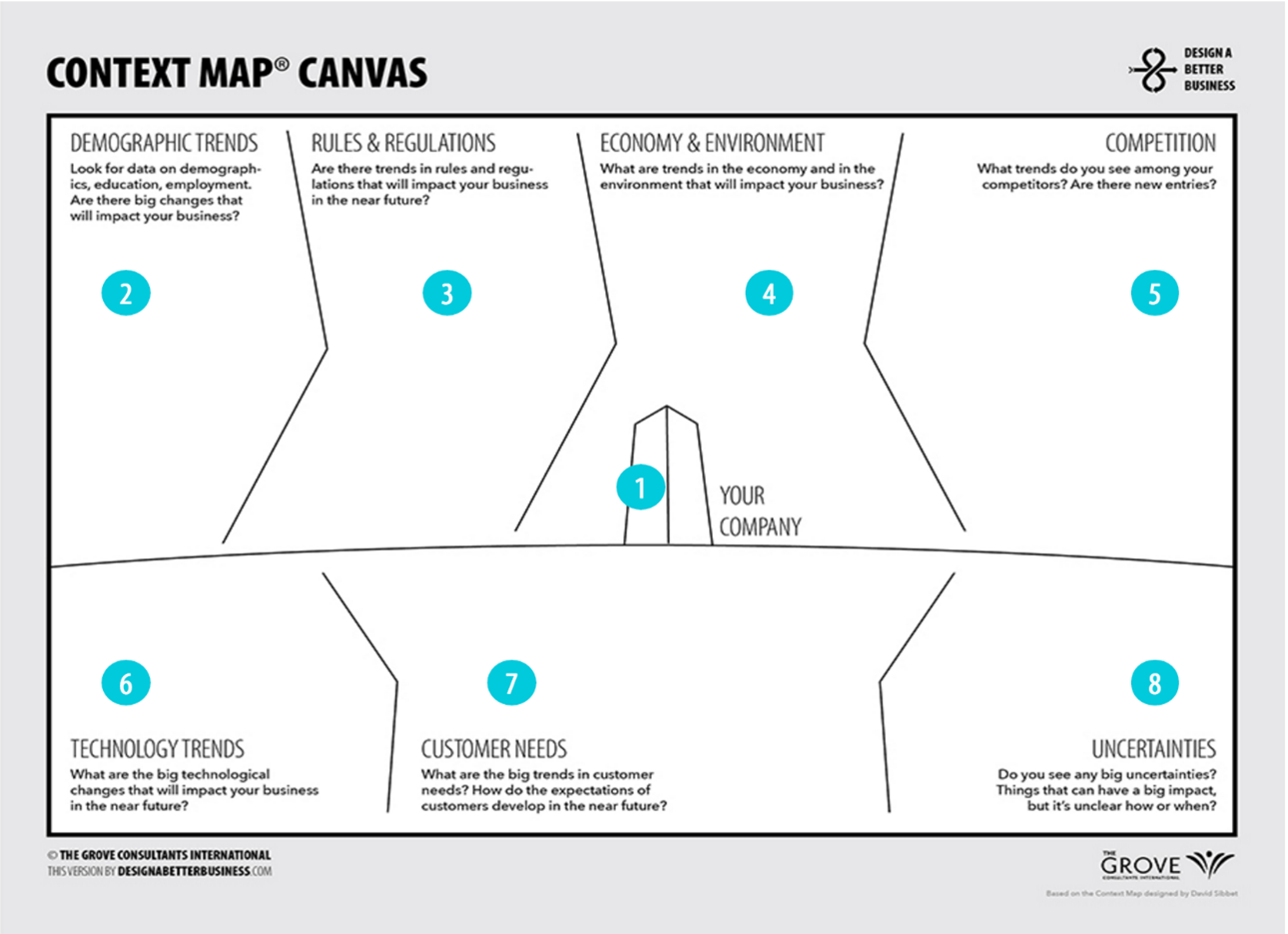

Online tools to use, when implementing participatory online events
The online events have become our reality. There are plenty of tools, how can we structure and create a participatory event online. Why is it important to include people in the structure of meetings and events? Because we know, how exhausting it can be, if we are online and not having a chance to speak for more than 30 minutes. Our mind starts to wander, we start to reply to emails, and we switch off. If there is one lesson we took from the pandemics, it is the importance of involving people into the processes and giving them the time, space and tools to participate and contribute into the processes.
Jamboard
Jamboard is a digital interactive whiteboard developed by Google to work with Google Workspace, formerly known as G Suite. It is the easiest tool to use and can be used for online collaboration using Google Workspace. It can be moderated to certain extent and can help to harvest the conversations in order for very simple activities. Works with post it-s and short texts.
When do we use it?
- Meetings
- Debates, that have outcomes
- Group work
- Exploration of new topics
Miro
Miro is the online collaborative whiteboard platform that enables distributed teams to work effectively together, from running brainstorming sessions and workshops to planning projects, from designing new products and services to facilitating agile ceremonies.
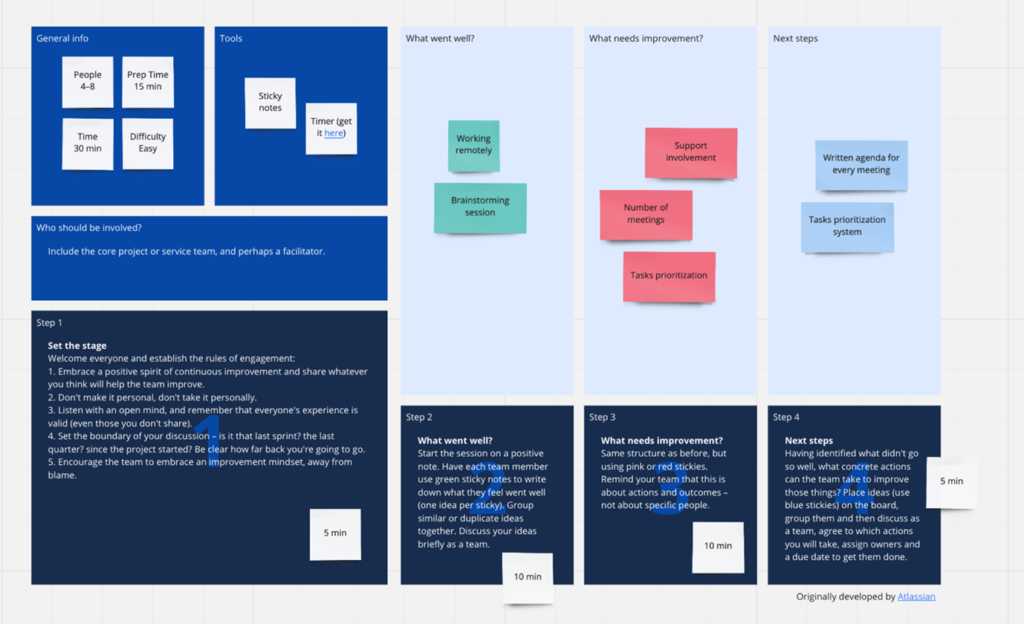
When do we use it?
- Complex Meetings
- Debates, that have outcomes
- Group work
- Exploration of new topics
- Planning of new project
- Strategic planning
- Design thinking processes
Mural
MURAL enables innovation at scale, providing a platform for product strategy and planning, the facilitation of immersive workshops using agile and design thinking methodologies, sales and consulting engagements, and research and design. When you have the space to make ideas visual, the methods to bring clarity to imagination, and the freedom to share your vision at any time, from anywhere, you can speed up the process of innovation. By functionalities, it is very similar to Miro.
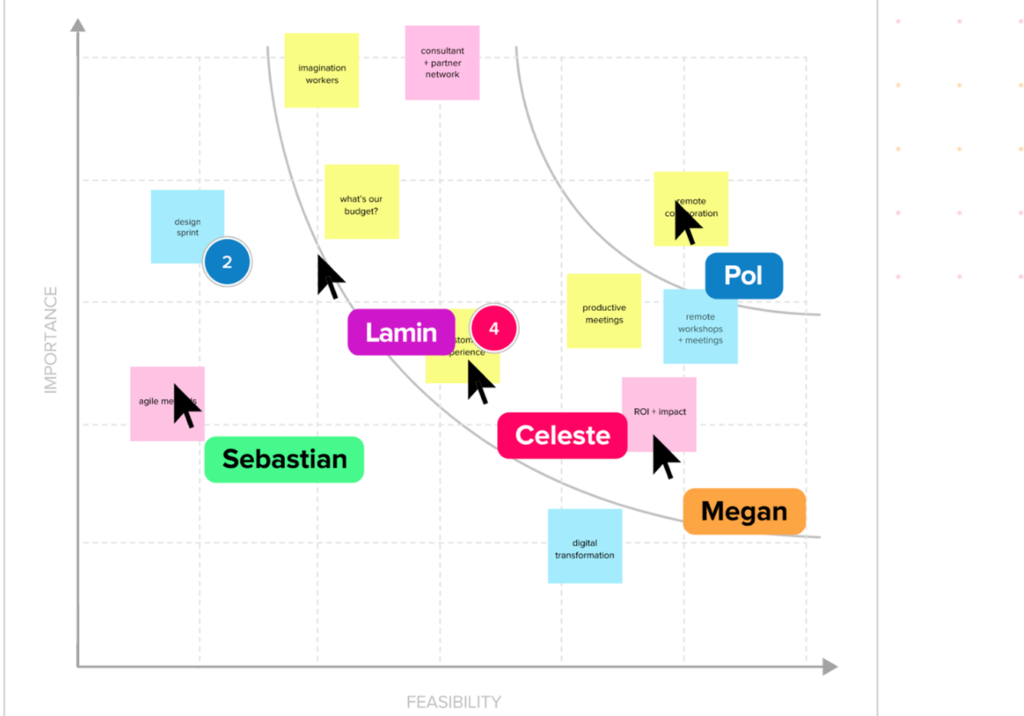
When do we use it?
- Complex Meetings
- Debates, that have outcomes
- Group work
- Exploration of new topics
- Planning of new project
- Strategic planning
- Design thinking processes
Wordwall
Wordwall is a tool, where you can create interesting activities, that in a participatory manner involve people in the processes and connecting them in different manners. It is a very easy tool to structure and help with the difficult topics to address in participatory way.
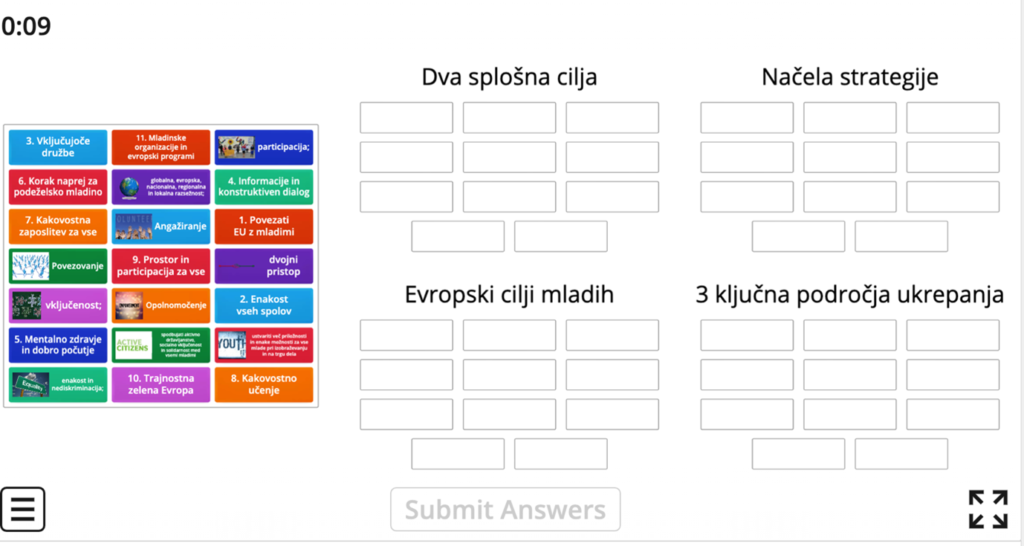
When do we use it?
- For getting to know strategic documents in a participatory manner
- To get to know each other
- To create a Quiz on the different topics
Mentimeter
Mentimeter is an easy-to-use presentation software used by more than 25 million people. With Mentimeter you can create fun and interactive presentations. The tool helps you to make your events, presentations, lectures, and workshops innovative and memorable.
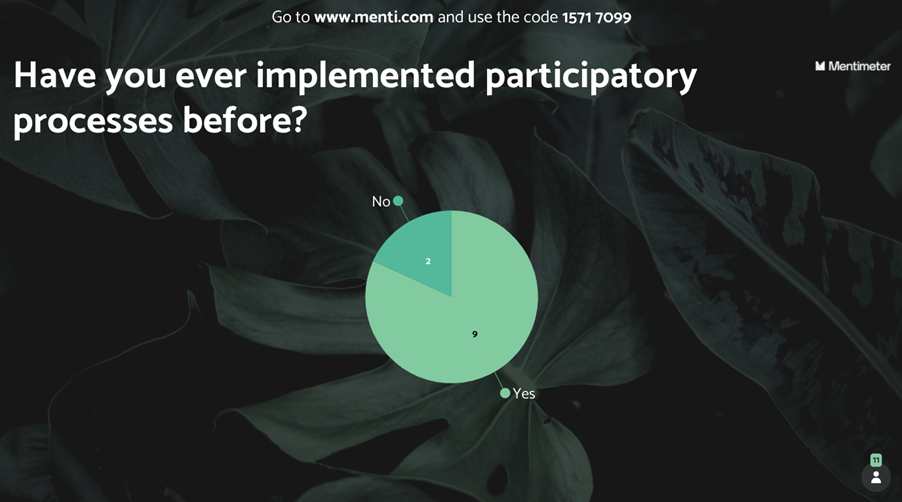
When to use it?
- As a check in
- As “in between questions” to open specific topics
- For evaluations
- For smaller or bigger crowds (up to 5000 participants)
Padlet
Padlet is a free online tool that is best described as an online notice board. Padlet can be used by participants of the events to post notes on a common page. The notes posted by participants can contain links, videos, images and document files. It is as well possible to map, where different participants are coming from.
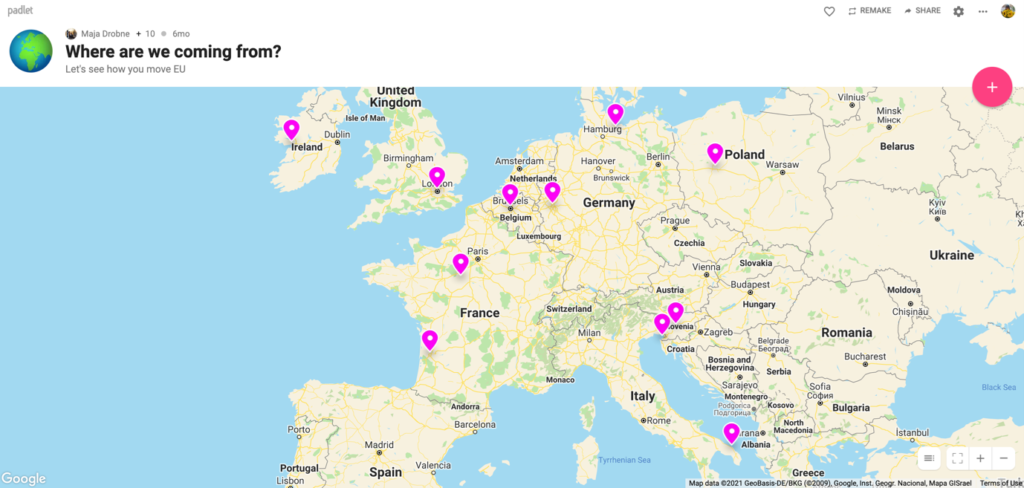
When to use it ?
- To present the schedule
- To map where participants are coming from
- For harvesting
- To present the participants of the event
- To gather all that is happening on the event in one place
Good practices
Participatory budget
Participatory budgeting (PB) is a democratic process in which community members decide how to spend part of a public budget. It gives people real power over real money. PB started in Porto Alegre, Brazil, in 1989, as an anti-poverty measure that helped reduce child mortality by nearly 20%. Since then PB has spread to over 7,000 cities around the world, and has been used to decide budgets from states, counties, cities, housing authorities, schools, and other institutions. The New York Times calls PB “revolutionary civics in action”— it deepens democracy, builds stronger communities, and creates a more equitable distribution of public resources.
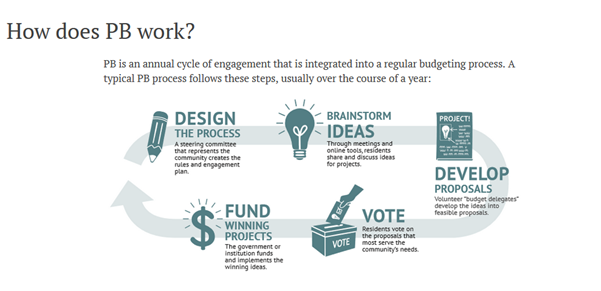
Participatory budget in Koper 2020/2021
PiNA has implemented 6 workshops and 6 project offices.
The Municipality created the structure of participatory budget divided on the separated counties of the Municipality and implemented one workshop in each area.
On the workshop, the structure of the participatory budget was presented, how to apply, the process of application was presented and application form was shown to the participants. Then there was the open space for questions.
Project offices were dedicated to the group of people or individuals with project idea, but no knowledge on how to structure it or that had open questions. In this manner, everybody had a chance to participate and the supporting mechanisms were there, to assure inclusion.
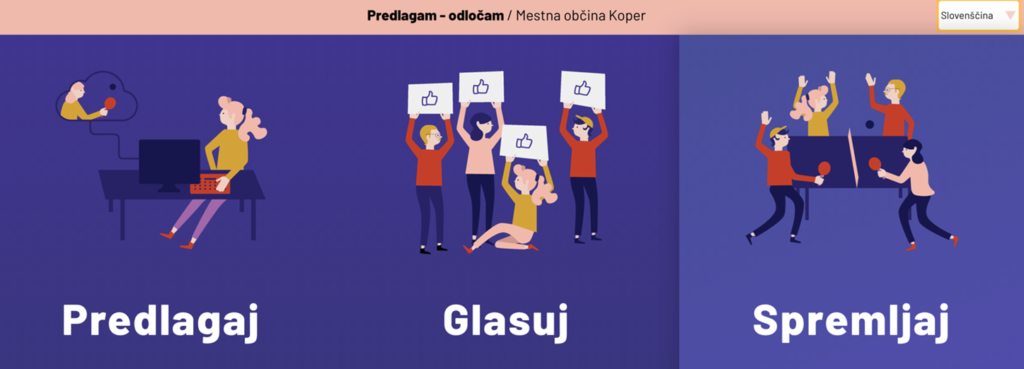
Participatory approach to urban act
The Municipality of Piran has completed 8 workshops to verify the strategic objectives of urban act development. The aim of the workshops was to promote understanding of planning and strengthen cooperation in society and that space is a limited common good. To this end, 8 interactive workshops organized, where it was outlined, together with the citizens, how the future of municipal space will look like. There were interactive workshops attended by more than 450 people who thought in small groups on the process of spatial planning in the municipality. Citizens most often suggested more green space, conservation of Istrian identity, preservation of cultural and architectural heritage and a more meaningful definition of building and agricultural land.
They consider that more attention needs to be paid to the rural tourism and the promotion of local agriculture sustainable development within the Municipality. Care for the elderly, the need for regulation, has been expressed several times nursing homes, sheltered housing and intergenerational centres. The process also highlighted many of the proposals cannot be addressed by the urban plan, but are key to development of the municipality, such as improving public transport and rural bus connections to the city that citizens would need.
Let’s draw the coast
In Slovenia, we often face negative public reactions when we introduce innovative measures or change public space and traffic regulation with approaches that we are not used to. Negative responses are most often the result of ineffective public involvement in decision-making processes. We are also often concerned that the involvement of the public will delay or even prevent the implementation of measures, so we avoid integration processes that would go beyond the legally prescribed requirements. In addition, solutions that are not developed through public involvement may be deficient, as public space planners understand and experience differently than residents who use this space on a daily basis.
Many European as well as some domestic examples show that involving the public in public spatial planning processes is already extremely useful and a good investment in the development and planning stages, as it improves the quality of solutions, changes public perception of the solution and has a positive effect on trust in local governments. In the area of the former coastal road between Koper and Izola, various non-governmental organizations, institutions and all other interested parties drew, wrote, wrote or otherwise designed the future of the coastal road on a 2 km long “roll” of paper spread in this area.
Some numbers about the event:
- developed 20 rolls of paper (each 100 m long),
- they were weighted with 532 granite cubes,
- pasted them with 200 numbers,
- The event was attended by more than 1,000 people from all over Slovenia, neighbouring Italy and various European countries,
- 618 individuals drew together in 75 groups,
- 3288 markers and 1750 crayons were used in the campaign,
- 1000 bottles of water were given to the members,
- Participants filled 750 m rolls of paper with ideas,
- in boxes there were also 78 written proposals received.
All proposals are extremely diverse and innovative. The participants mostly prepared for the event in advance, which shows that they recognized the importance of community planning of this space.
Conclusion
Covid 19 situation told us more than ever, how much we need the processes of participation and why it is important to open the safe space of creating communities. Sometimes focused on the physical space, but more and more as well creating the online learning spaces to share, to see different views, to recognize good practices. In this publication you can see all the different tools and possibilities to create a collaborative space, that is participatory, where the voice of people matter, where everyone is heard and also the space, that politics can use to achieve the changes.
Literature
- Arthur, Mary Alice, 2020. Core art of hosting practices. http://artofhosting.ning.com/page/core-art-of-hosting-practices
- Art of hosting webpage, 2020. (available on: http://artofhosting.ning.com/forum/topics/passion-‐for-‐pro-‐action-‐cafe, 20.4.2020)
- Cserti, Robert. 2020. 45 Ice Breaker Games [That Your Team Won’t Find Cheesy] (available on: https://www.sessionlab.com/blog/icebreaker-games/, 3. 6. 2020)
- Fenton, Amanda. 2015. Collective story harvesting (available on: https://www.plays-in-business.com/collective-story-harvesting/, 18.4.2020)
- Juanita Brown, David Isaacs. 2020. The World Café: Shaping Our Futures Through Conversations That Matter (available on: https://www.artofhosting.org/ , 13.4.2020)
- Visser, Willemien. 2006. The cognitive artifacts of designing, Lawrence Erlbaum Associates
